Activity Based Costing Analysis and Recommendations for BOQ
VerifiedAdded on 2021/05/31
|15
|3175
|26
Report
AI Summary
This report examines the application of Activity-Based Costing (ABC) within the Bank of Queensland (BOQ). It begins with an overview of ABC, detailing its features and benefits in improving cost allocation and financial performance. The report then analyzes how BOQ can leverage ABC to align with i...

Activity based costing 1
ACTIVITY BASED COSTING
By (Student’s Name)
Professor’s Name
College
Course
Date
ACTIVITY BASED COSTING
By (Student’s Name)
Professor’s Name
College
Course
Date
Paraphrase This Document
Need a fresh take? Get an instant paraphrase of this document with our AI Paraphraser
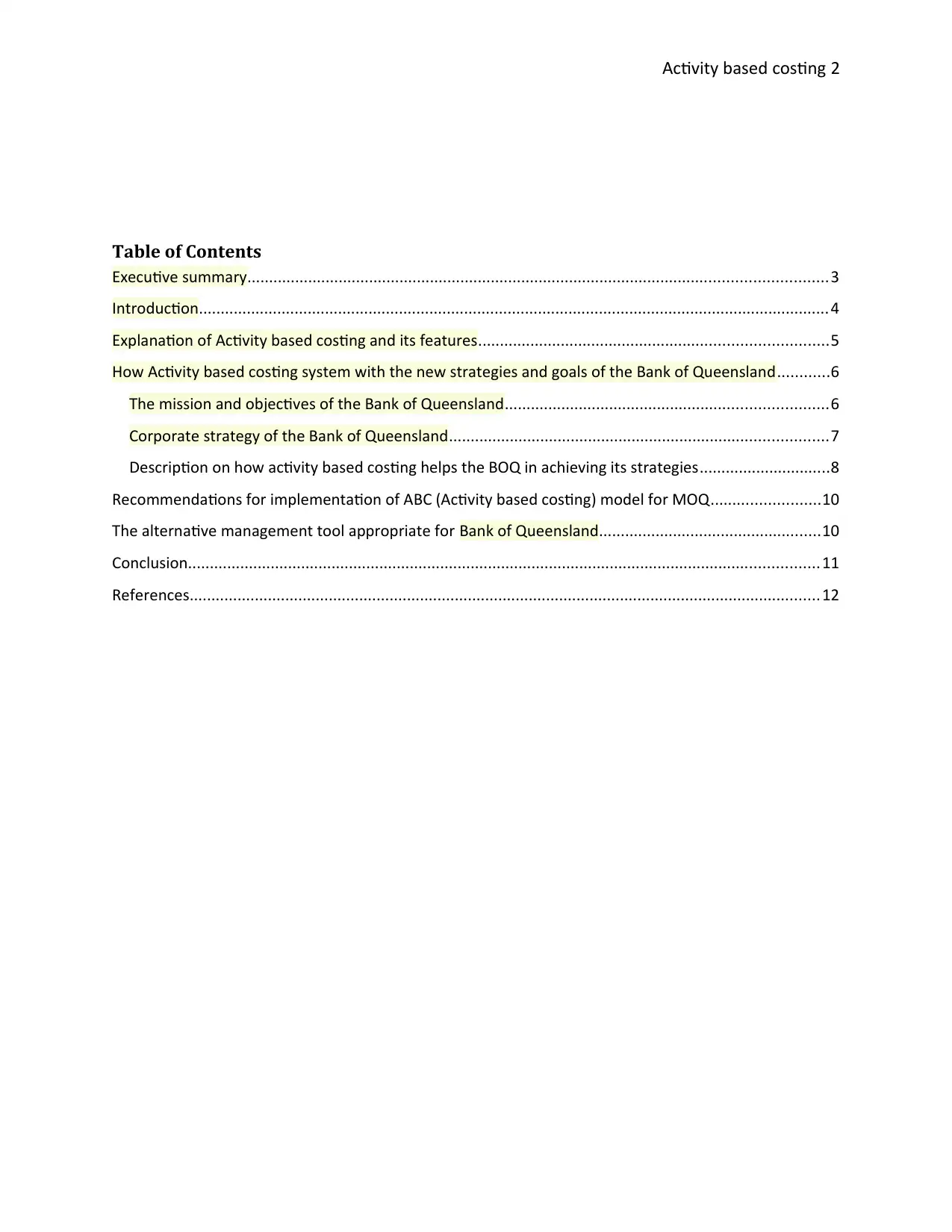
Activity based costing 2
Table of Contents
Executive summary.....................................................................................................................................3
Introduction.................................................................................................................................................4
Explanation of Activity based costing and its features................................................................................5
How Activity based costing system with the new strategies and goals of the Bank of Queensland............6
The mission and objectives of the Bank of Queensland..........................................................................6
Corporate strategy of the Bank of Queensland.......................................................................................7
Description on how activity based costing helps the BOQ in achieving its strategies..............................8
Recommendations for implementation of ABC (Activity based costing) model for MOQ.........................10
The alternative management tool appropriate for Bank of Queensland...................................................10
Conclusion.................................................................................................................................................11
References.................................................................................................................................................12
Table of Contents
Executive summary.....................................................................................................................................3
Introduction.................................................................................................................................................4
Explanation of Activity based costing and its features................................................................................5
How Activity based costing system with the new strategies and goals of the Bank of Queensland............6
The mission and objectives of the Bank of Queensland..........................................................................6
Corporate strategy of the Bank of Queensland.......................................................................................7
Description on how activity based costing helps the BOQ in achieving its strategies..............................8
Recommendations for implementation of ABC (Activity based costing) model for MOQ.........................10
The alternative management tool appropriate for Bank of Queensland...................................................10
Conclusion.................................................................................................................................................11
References.................................................................................................................................................12
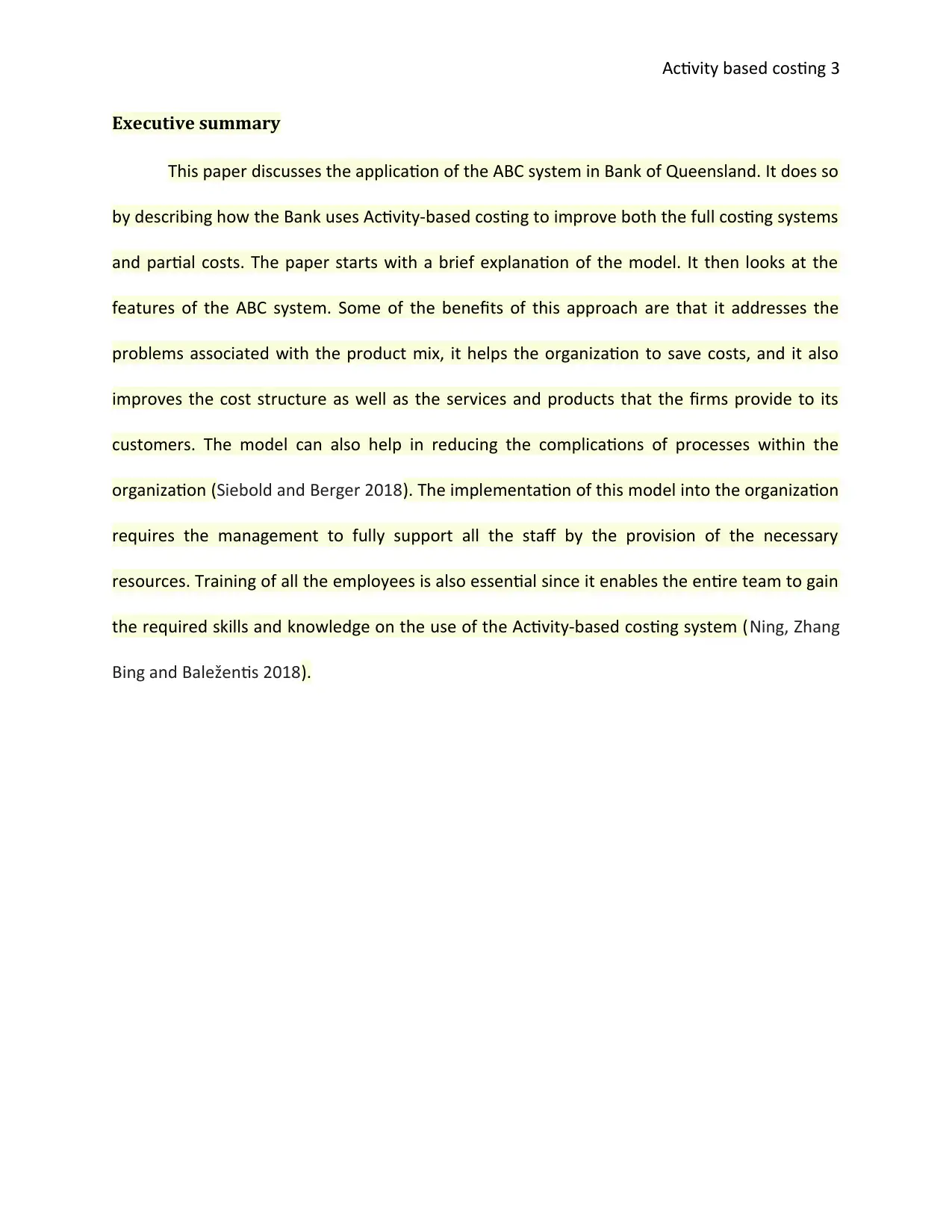
Activity based costing 3
Executive summary
This paper discusses the application of the ABC system in Bank of Queensland. It does so
by describing how the Bank uses Activity-based costing to improve both the full costing systems
and partial costs. The paper starts with a brief explanation of the model. It then looks at the
features of the ABC system. Some of the benefits of this approach are that it addresses the
problems associated with the product mix, it helps the organization to save costs, and it also
improves the cost structure as well as the services and products that the firms provide to its
customers. The model can also help in reducing the complications of processes within the
organization (Siebold and Berger 2018). The implementation of this model into the organization
requires the management to fully support all the staff by the provision of the necessary
resources. Training of all the employees is also essential since it enables the entire team to gain
the required skills and knowledge on the use of the Activity-based costing system (Ning, Zhang
Bing and Baležentis 2018).
Executive summary
This paper discusses the application of the ABC system in Bank of Queensland. It does so
by describing how the Bank uses Activity-based costing to improve both the full costing systems
and partial costs. The paper starts with a brief explanation of the model. It then looks at the
features of the ABC system. Some of the benefits of this approach are that it addresses the
problems associated with the product mix, it helps the organization to save costs, and it also
improves the cost structure as well as the services and products that the firms provide to its
customers. The model can also help in reducing the complications of processes within the
organization (Siebold and Berger 2018). The implementation of this model into the organization
requires the management to fully support all the staff by the provision of the necessary
resources. Training of all the employees is also essential since it enables the entire team to gain
the required skills and knowledge on the use of the Activity-based costing system (Ning, Zhang
Bing and Baležentis 2018).
⊘ This is a preview!⊘
Do you want full access?
Subscribe today to unlock all pages.

Trusted by 1+ million students worldwide
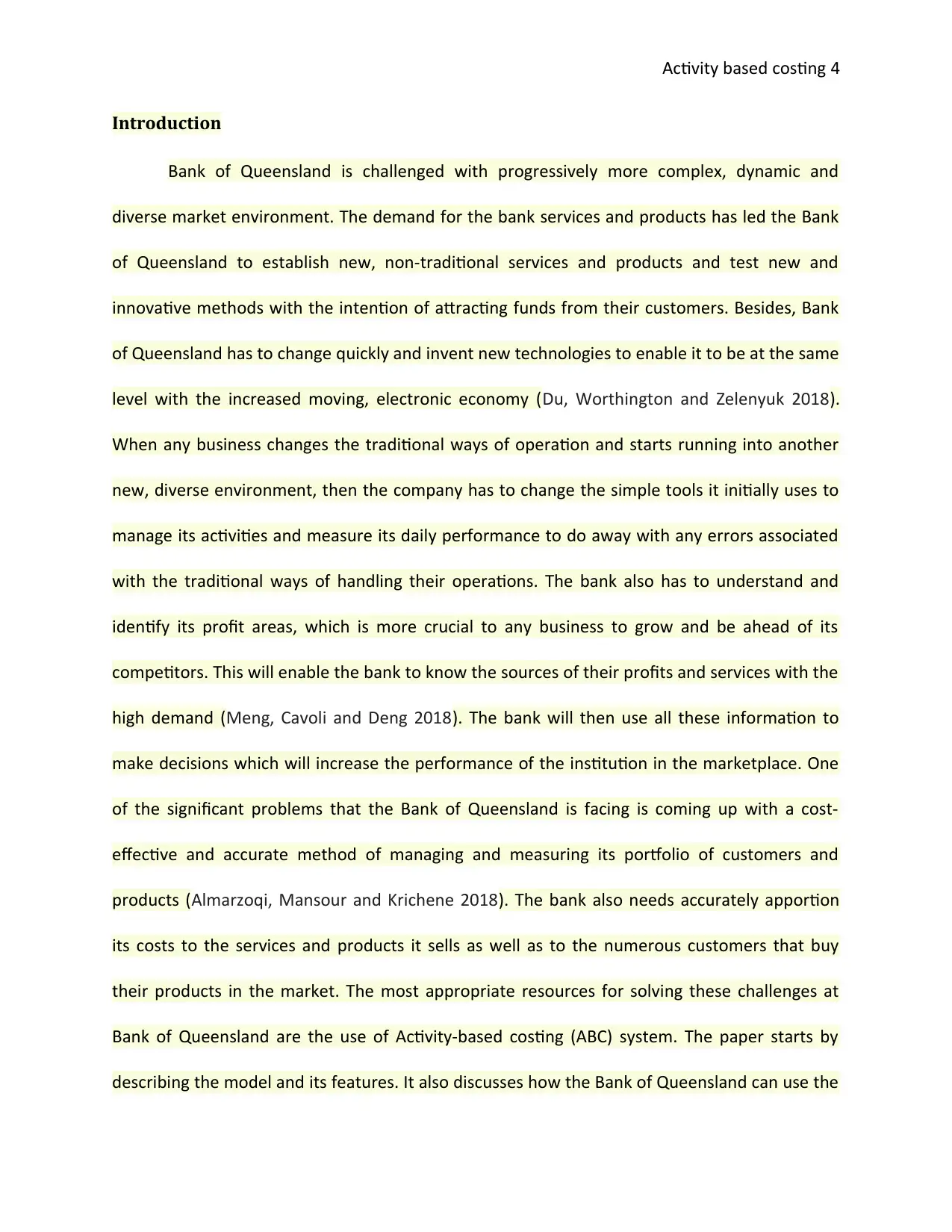
Activity based costing 4
Introduction
Bank of Queensland is challenged with progressively more complex, dynamic and
diverse market environment. The demand for the bank services and products has led the Bank
of Queensland to establish new, non-traditional services and products and test new and
innovative methods with the intention of attracting funds from their customers. Besides, Bank
of Queensland has to change quickly and invent new technologies to enable it to be at the same
level with the increased moving, electronic economy (Du, Worthington and Zelenyuk 2018).
When any business changes the traditional ways of operation and starts running into another
new, diverse environment, then the company has to change the simple tools it initially uses to
manage its activities and measure its daily performance to do away with any errors associated
with the traditional ways of handling their operations. The bank also has to understand and
identify its profit areas, which is more crucial to any business to grow and be ahead of its
competitors. This will enable the bank to know the sources of their profits and services with the
high demand (Meng, Cavoli and Deng 2018). The bank will then use all these information to
make decisions which will increase the performance of the institution in the marketplace. One
of the significant problems that the Bank of Queensland is facing is coming up with a cost-
effective and accurate method of managing and measuring its portfolio of customers and
products (Almarzoqi, Mansour and Krichene 2018). The bank also needs accurately apportion
its costs to the services and products it sells as well as to the numerous customers that buy
their products in the market. The most appropriate resources for solving these challenges at
Bank of Queensland are the use of Activity-based costing (ABC) system. The paper starts by
describing the model and its features. It also discusses how the Bank of Queensland can use the
Introduction
Bank of Queensland is challenged with progressively more complex, dynamic and
diverse market environment. The demand for the bank services and products has led the Bank
of Queensland to establish new, non-traditional services and products and test new and
innovative methods with the intention of attracting funds from their customers. Besides, Bank
of Queensland has to change quickly and invent new technologies to enable it to be at the same
level with the increased moving, electronic economy (Du, Worthington and Zelenyuk 2018).
When any business changes the traditional ways of operation and starts running into another
new, diverse environment, then the company has to change the simple tools it initially uses to
manage its activities and measure its daily performance to do away with any errors associated
with the traditional ways of handling their operations. The bank also has to understand and
identify its profit areas, which is more crucial to any business to grow and be ahead of its
competitors. This will enable the bank to know the sources of their profits and services with the
high demand (Meng, Cavoli and Deng 2018). The bank will then use all these information to
make decisions which will increase the performance of the institution in the marketplace. One
of the significant problems that the Bank of Queensland is facing is coming up with a cost-
effective and accurate method of managing and measuring its portfolio of customers and
products (Almarzoqi, Mansour and Krichene 2018). The bank also needs accurately apportion
its costs to the services and products it sells as well as to the numerous customers that buy
their products in the market. The most appropriate resources for solving these challenges at
Bank of Queensland are the use of Activity-based costing (ABC) system. The paper starts by
describing the model and its features. It also discusses how the Bank of Queensland can use the
Paraphrase This Document
Need a fresh take? Get an instant paraphrase of this document with our AI Paraphraser
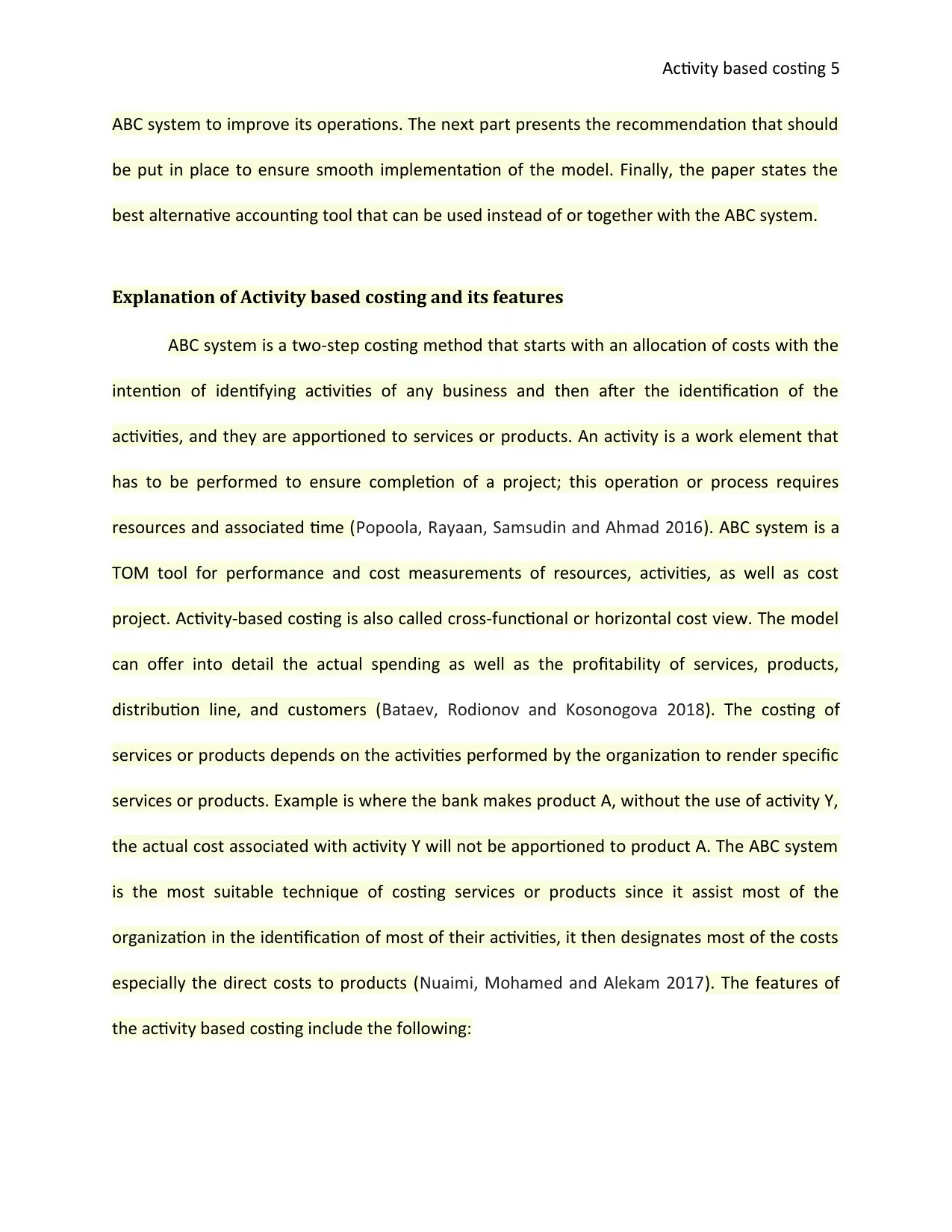
Activity based costing 5
ABC system to improve its operations. The next part presents the recommendation that should
be put in place to ensure smooth implementation of the model. Finally, the paper states the
best alternative accounting tool that can be used instead of or together with the ABC system.
Explanation of Activity based costing and its features
ABC system is a two-step costing method that starts with an allocation of costs with the
intention of identifying activities of any business and then after the identification of the
activities, and they are apportioned to services or products. An activity is a work element that
has to be performed to ensure completion of a project; this operation or process requires
resources and associated time (Popoola, Rayaan, Samsudin and Ahmad 2016). ABC system is a
TOM tool for performance and cost measurements of resources, activities, as well as cost
project. Activity-based costing is also called cross-functional or horizontal cost view. The model
can offer into detail the actual spending as well as the profitability of services, products,
distribution line, and customers (Bataev, Rodionov and Kosonogova 2018). The costing of
services or products depends on the activities performed by the organization to render specific
services or products. Example is where the bank makes product A, without the use of activity Y,
the actual cost associated with activity Y will not be apportioned to product A. The ABC system
is the most suitable technique of costing services or products since it assist most of the
organization in the identification of most of their activities, it then designates most of the costs
especially the direct costs to products (Nuaimi, Mohamed and Alekam 2017). The features of
the activity based costing include the following:
ABC system to improve its operations. The next part presents the recommendation that should
be put in place to ensure smooth implementation of the model. Finally, the paper states the
best alternative accounting tool that can be used instead of or together with the ABC system.
Explanation of Activity based costing and its features
ABC system is a two-step costing method that starts with an allocation of costs with the
intention of identifying activities of any business and then after the identification of the
activities, and they are apportioned to services or products. An activity is a work element that
has to be performed to ensure completion of a project; this operation or process requires
resources and associated time (Popoola, Rayaan, Samsudin and Ahmad 2016). ABC system is a
TOM tool for performance and cost measurements of resources, activities, as well as cost
project. Activity-based costing is also called cross-functional or horizontal cost view. The model
can offer into detail the actual spending as well as the profitability of services, products,
distribution line, and customers (Bataev, Rodionov and Kosonogova 2018). The costing of
services or products depends on the activities performed by the organization to render specific
services or products. Example is where the bank makes product A, without the use of activity Y,
the actual cost associated with activity Y will not be apportioned to product A. The ABC system
is the most suitable technique of costing services or products since it assist most of the
organization in the identification of most of their activities, it then designates most of the costs
especially the direct costs to products (Nuaimi, Mohamed and Alekam 2017). The features of
the activity based costing include the following:
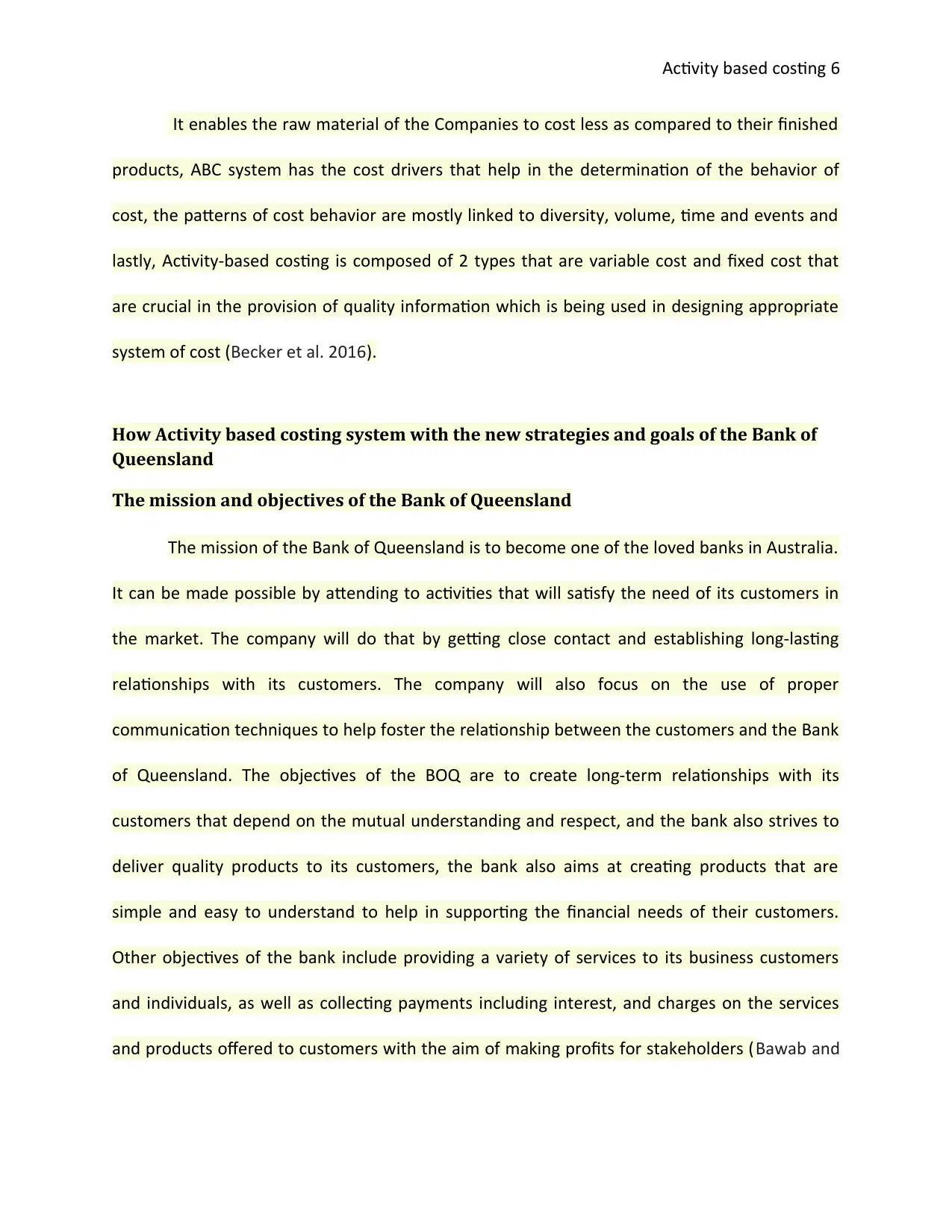
Activity based costing 6
It enables the raw material of the Companies to cost less as compared to their finished
products, ABC system has the cost drivers that help in the determination of the behavior of
cost, the patterns of cost behavior are mostly linked to diversity, volume, time and events and
lastly, Activity-based costing is composed of 2 types that are variable cost and fixed cost that
are crucial in the provision of quality information which is being used in designing appropriate
system of cost (Becker et al. 2016).
How Activity based costing system with the new strategies and goals of the Bank of
Queensland
The mission and objectives of the Bank of Queensland
The mission of the Bank of Queensland is to become one of the loved banks in Australia.
It can be made possible by attending to activities that will satisfy the need of its customers in
the market. The company will do that by getting close contact and establishing long-lasting
relationships with its customers. The company will also focus on the use of proper
communication techniques to help foster the relationship between the customers and the Bank
of Queensland. The objectives of the BOQ are to create long-term relationships with its
customers that depend on the mutual understanding and respect, and the bank also strives to
deliver quality products to its customers, the bank also aims at creating products that are
simple and easy to understand to help in supporting the financial needs of their customers.
Other objectives of the bank include providing a variety of services to its business customers
and individuals, as well as collecting payments including interest, and charges on the services
and products offered to customers with the aim of making profits for stakeholders (Bawab and
It enables the raw material of the Companies to cost less as compared to their finished
products, ABC system has the cost drivers that help in the determination of the behavior of
cost, the patterns of cost behavior are mostly linked to diversity, volume, time and events and
lastly, Activity-based costing is composed of 2 types that are variable cost and fixed cost that
are crucial in the provision of quality information which is being used in designing appropriate
system of cost (Becker et al. 2016).
How Activity based costing system with the new strategies and goals of the Bank of
Queensland
The mission and objectives of the Bank of Queensland
The mission of the Bank of Queensland is to become one of the loved banks in Australia.
It can be made possible by attending to activities that will satisfy the need of its customers in
the market. The company will do that by getting close contact and establishing long-lasting
relationships with its customers. The company will also focus on the use of proper
communication techniques to help foster the relationship between the customers and the Bank
of Queensland. The objectives of the BOQ are to create long-term relationships with its
customers that depend on the mutual understanding and respect, and the bank also strives to
deliver quality products to its customers, the bank also aims at creating products that are
simple and easy to understand to help in supporting the financial needs of their customers.
Other objectives of the bank include providing a variety of services to its business customers
and individuals, as well as collecting payments including interest, and charges on the services
and products offered to customers with the aim of making profits for stakeholders (Bawab and
⊘ This is a preview!⊘
Do you want full access?
Subscribe today to unlock all pages.

Trusted by 1+ million students worldwide

Activity based costing 7
Rawashdeh 2016). The bank also aims at changing the living standard of most of the people by
alleviating poverty in the country.
Corporate strategy of the Bank of Queensland
The Bank of Queensland made use of marketing strategy. The marketing team creates
good relationships between the bank and its customers in the marketplace. Through this
strategy, the bank will promote most of its services and many people will start to buy and use
their services hence leading to increased sales. The team will use the clash board to help in
tracking of all the performance of the campaign.
BOQ also merger with different banks such as the Metro bank, IGObaking and
Commerce Bank with the aim of getting a clear path of how to improve their returns by putting
their focus on geography/customers industry specialization. The three banks will divide the
market into segments, and each will target different areas with Commercial bank focusing on
Healthcare, Agribusiness, distribution and marketing, Metro Bank will put their target mainly on
the retail business, and lastly, IGObaking will target the ethnic client. There are four potential
strategies of the BOQ that is the Business vertical strategy, High share of wallet, national
strategy and Direct banking channel and B2B
Rawashdeh 2016). The bank also aims at changing the living standard of most of the people by
alleviating poverty in the country.
Corporate strategy of the Bank of Queensland
The Bank of Queensland made use of marketing strategy. The marketing team creates
good relationships between the bank and its customers in the marketplace. Through this
strategy, the bank will promote most of its services and many people will start to buy and use
their services hence leading to increased sales. The team will use the clash board to help in
tracking of all the performance of the campaign.
BOQ also merger with different banks such as the Metro bank, IGObaking and
Commerce Bank with the aim of getting a clear path of how to improve their returns by putting
their focus on geography/customers industry specialization. The three banks will divide the
market into segments, and each will target different areas with Commercial bank focusing on
Healthcare, Agribusiness, distribution and marketing, Metro Bank will put their target mainly on
the retail business, and lastly, IGObaking will target the ethnic client. There are four potential
strategies of the BOQ that is the Business vertical strategy, High share of wallet, national
strategy and Direct banking channel and B2B
Paraphrase This Document
Need a fresh take? Get an instant paraphrase of this document with our AI Paraphraser
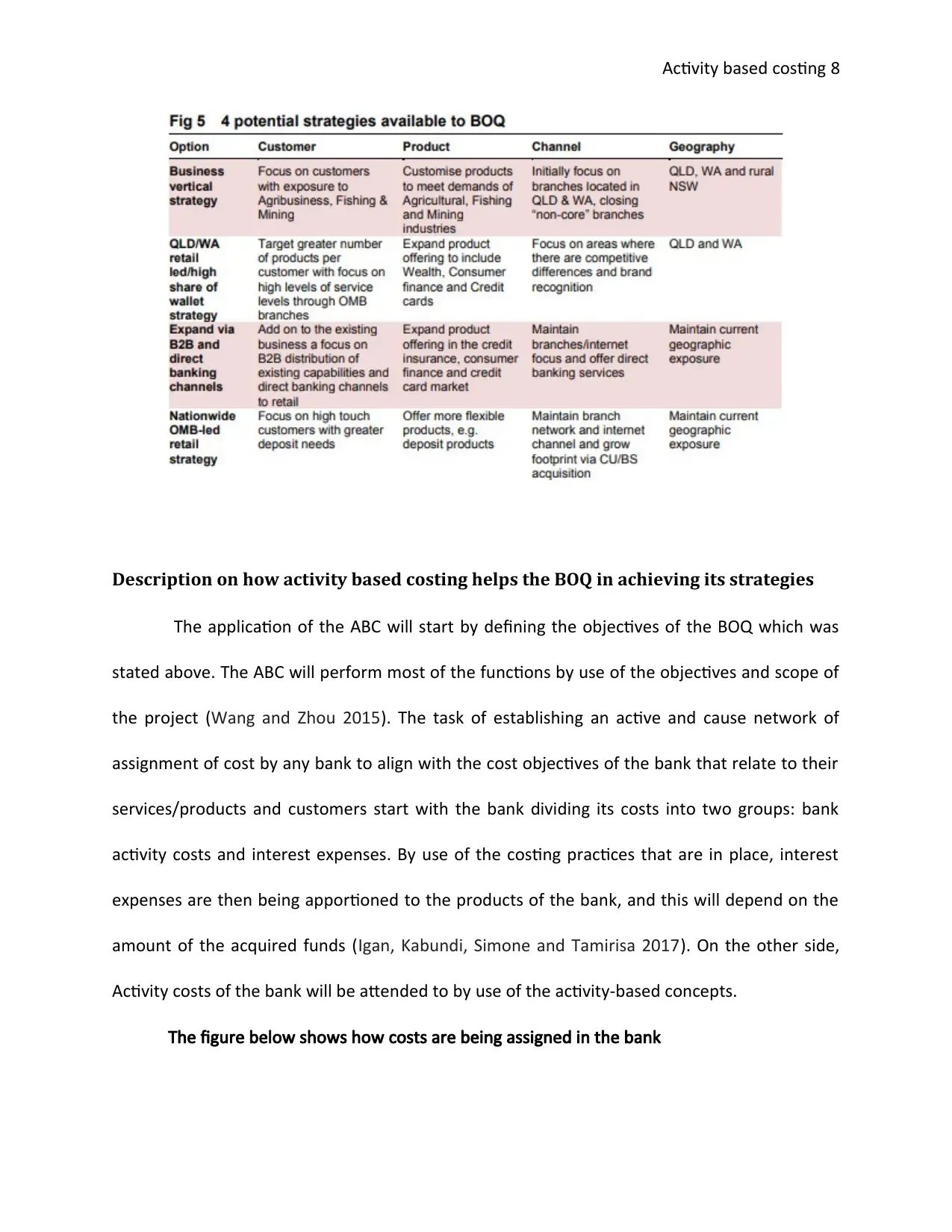
Activity based costing 8
Description on how activity based costing helps the BOQ in achieving its strategies
The application of the ABC will start by defining the objectives of the BOQ which was
stated above. The ABC will perform most of the functions by use of the objectives and scope of
the project (Wang and Zhou 2015). The task of establishing an active and cause network of
assignment of cost by any bank to align with the cost objectives of the bank that relate to their
services/products and customers start with the bank dividing its costs into two groups: bank
activity costs and interest expenses. By use of the costing practices that are in place, interest
expenses are then being apportioned to the products of the bank, and this will depend on the
amount of the acquired funds (Igan, Kabundi, Simone and Tamirisa 2017). On the other side,
Activity costs of the bank will be attended to by use of the activity-based concepts.
The figure below shows how costs are being assigned in the bank
Description on how activity based costing helps the BOQ in achieving its strategies
The application of the ABC will start by defining the objectives of the BOQ which was
stated above. The ABC will perform most of the functions by use of the objectives and scope of
the project (Wang and Zhou 2015). The task of establishing an active and cause network of
assignment of cost by any bank to align with the cost objectives of the bank that relate to their
services/products and customers start with the bank dividing its costs into two groups: bank
activity costs and interest expenses. By use of the costing practices that are in place, interest
expenses are then being apportioned to the products of the bank, and this will depend on the
amount of the acquired funds (Igan, Kabundi, Simone and Tamirisa 2017). On the other side,
Activity costs of the bank will be attended to by use of the activity-based concepts.
The figure below shows how costs are being assigned in the bank
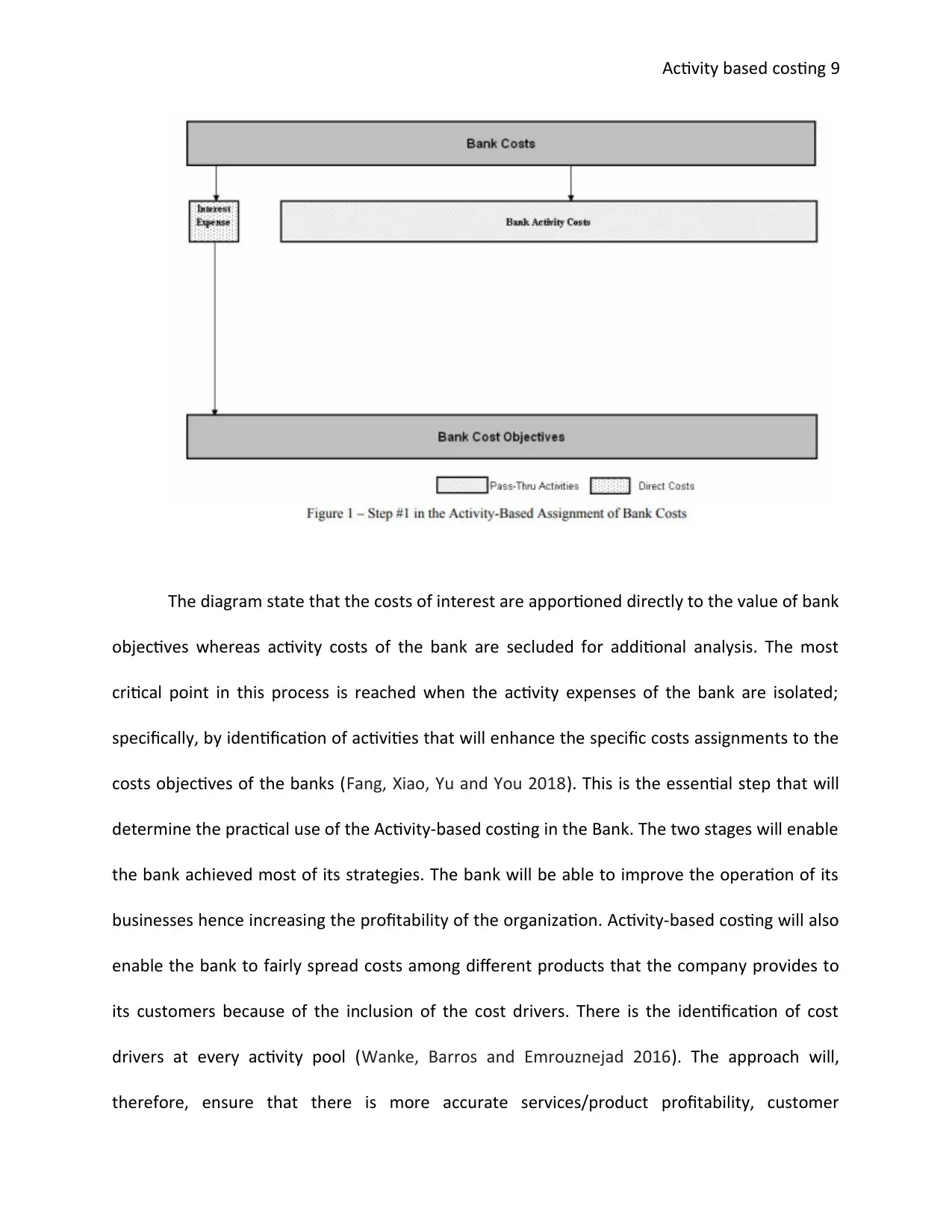
Activity based costing 9
The diagram state that the costs of interest are apportioned directly to the value of bank
objectives whereas activity costs of the bank are secluded for additional analysis. The most
critical point in this process is reached when the activity expenses of the bank are isolated;
specifically, by identification of activities that will enhance the specific costs assignments to the
costs objectives of the banks (Fang, Xiao, Yu and You 2018). This is the essential step that will
determine the practical use of the Activity-based costing in the Bank. The two stages will enable
the bank achieved most of its strategies. The bank will be able to improve the operation of its
businesses hence increasing the profitability of the organization. Activity-based costing will also
enable the bank to fairly spread costs among different products that the company provides to
its customers because of the inclusion of the cost drivers. There is the identification of cost
drivers at every activity pool (Wanke, Barros and Emrouznejad 2016). The approach will,
therefore, ensure that there is more accurate services/product profitability, customer
The diagram state that the costs of interest are apportioned directly to the value of bank
objectives whereas activity costs of the bank are secluded for additional analysis. The most
critical point in this process is reached when the activity expenses of the bank are isolated;
specifically, by identification of activities that will enhance the specific costs assignments to the
costs objectives of the banks (Fang, Xiao, Yu and You 2018). This is the essential step that will
determine the practical use of the Activity-based costing in the Bank. The two stages will enable
the bank achieved most of its strategies. The bank will be able to improve the operation of its
businesses hence increasing the profitability of the organization. Activity-based costing will also
enable the bank to fairly spread costs among different products that the company provides to
its customers because of the inclusion of the cost drivers. There is the identification of cost
drivers at every activity pool (Wanke, Barros and Emrouznejad 2016). The approach will,
therefore, ensure that there is more accurate services/product profitability, customer
⊘ This is a preview!⊘
Do you want full access?
Subscribe today to unlock all pages.

Trusted by 1+ million students worldwide
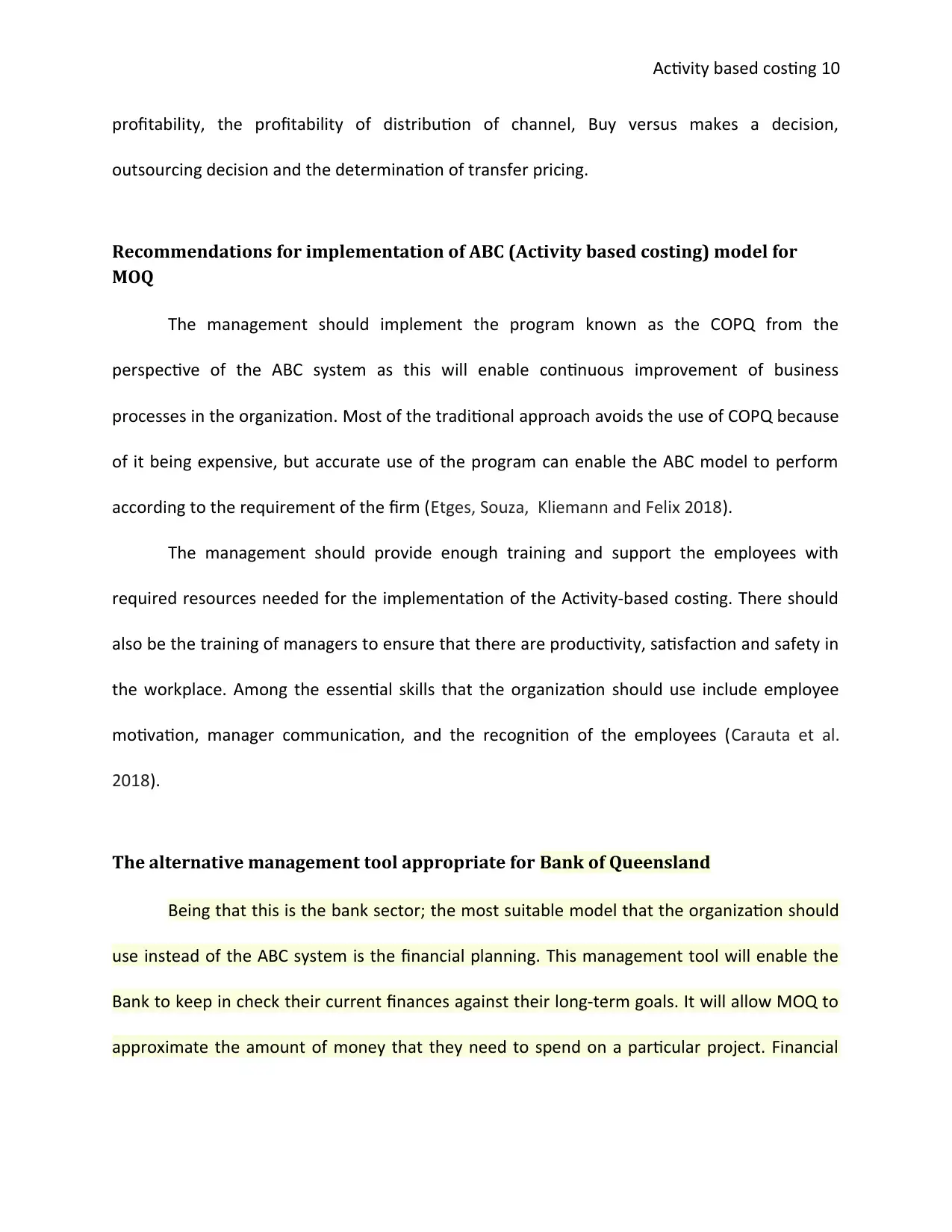
Activity based costing 10
profitability, the profitability of distribution of channel, Buy versus makes a decision,
outsourcing decision and the determination of transfer pricing.
Recommendations for implementation of ABC (Activity based costing) model for
MOQ
The management should implement the program known as the COPQ from the
perspective of the ABC system as this will enable continuous improvement of business
processes in the organization. Most of the traditional approach avoids the use of COPQ because
of it being expensive, but accurate use of the program can enable the ABC model to perform
according to the requirement of the firm (Etges, Souza, Kliemann and Felix 2018).
The management should provide enough training and support the employees with
required resources needed for the implementation of the Activity-based costing. There should
also be the training of managers to ensure that there are productivity, satisfaction and safety in
the workplace. Among the essential skills that the organization should use include employee
motivation, manager communication, and the recognition of the employees (Carauta et al.
2018).
The alternative management tool appropriate for Bank of Queensland
Being that this is the bank sector; the most suitable model that the organization should
use instead of the ABC system is the financial planning. This management tool will enable the
Bank to keep in check their current finances against their long-term goals. It will allow MOQ to
approximate the amount of money that they need to spend on a particular project. Financial
profitability, the profitability of distribution of channel, Buy versus makes a decision,
outsourcing decision and the determination of transfer pricing.
Recommendations for implementation of ABC (Activity based costing) model for
MOQ
The management should implement the program known as the COPQ from the
perspective of the ABC system as this will enable continuous improvement of business
processes in the organization. Most of the traditional approach avoids the use of COPQ because
of it being expensive, but accurate use of the program can enable the ABC model to perform
according to the requirement of the firm (Etges, Souza, Kliemann and Felix 2018).
The management should provide enough training and support the employees with
required resources needed for the implementation of the Activity-based costing. There should
also be the training of managers to ensure that there are productivity, satisfaction and safety in
the workplace. Among the essential skills that the organization should use include employee
motivation, manager communication, and the recognition of the employees (Carauta et al.
2018).
The alternative management tool appropriate for Bank of Queensland
Being that this is the bank sector; the most suitable model that the organization should
use instead of the ABC system is the financial planning. This management tool will enable the
Bank to keep in check their current finances against their long-term goals. It will allow MOQ to
approximate the amount of money that they need to spend on a particular project. Financial
Paraphrase This Document
Need a fresh take? Get an instant paraphrase of this document with our AI Paraphraser
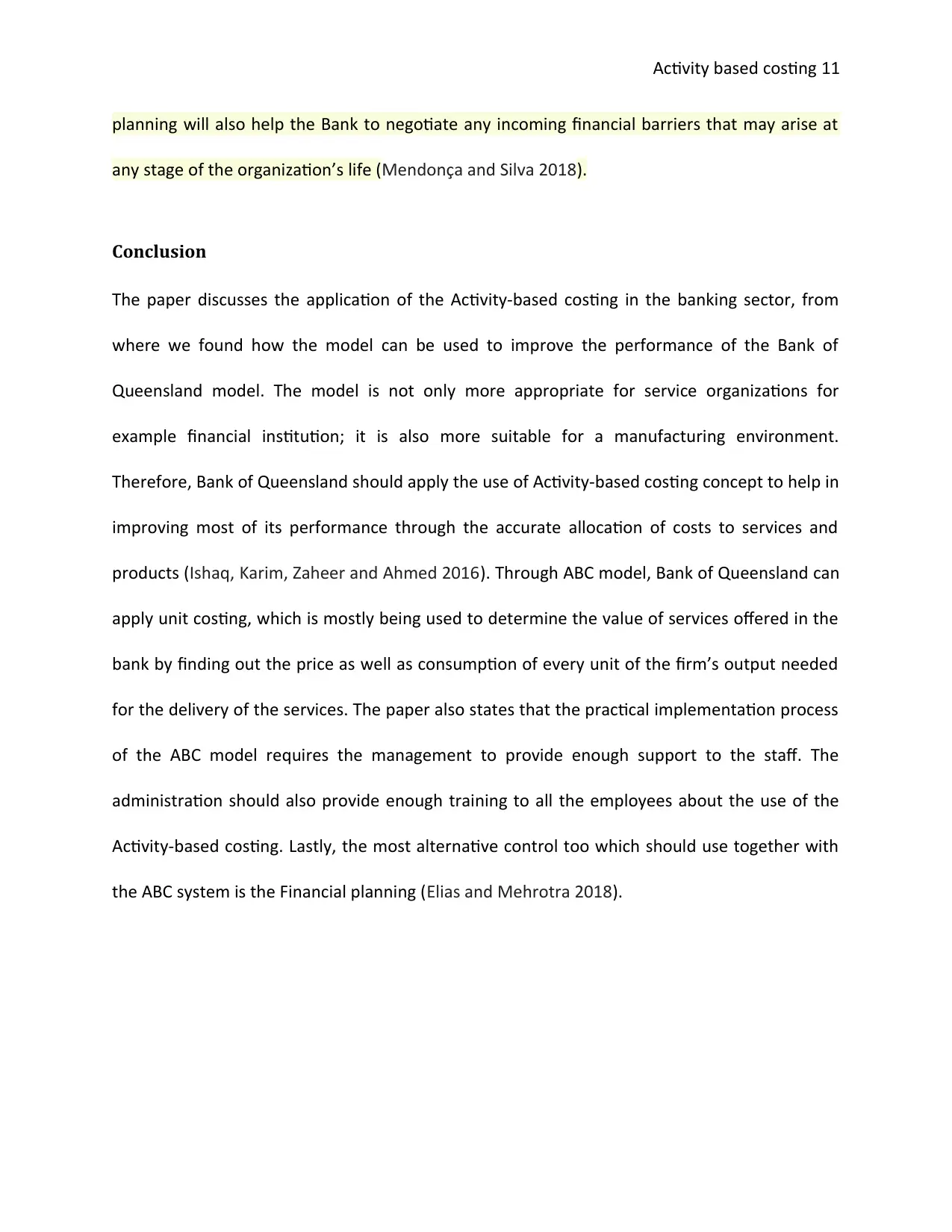
Activity based costing 11
planning will also help the Bank to negotiate any incoming financial barriers that may arise at
any stage of the organization’s life (Mendonça and Silva 2018).
Conclusion
The paper discusses the application of the Activity-based costing in the banking sector, from
where we found how the model can be used to improve the performance of the Bank of
Queensland model. The model is not only more appropriate for service organizations for
example financial institution; it is also more suitable for a manufacturing environment.
Therefore, Bank of Queensland should apply the use of Activity-based costing concept to help in
improving most of its performance through the accurate allocation of costs to services and
products (Ishaq, Karim, Zaheer and Ahmed 2016). Through ABC model, Bank of Queensland can
apply unit costing, which is mostly being used to determine the value of services offered in the
bank by finding out the price as well as consumption of every unit of the firm’s output needed
for the delivery of the services. The paper also states that the practical implementation process
of the ABC model requires the management to provide enough support to the staff. The
administration should also provide enough training to all the employees about the use of the
Activity-based costing. Lastly, the most alternative control too which should use together with
the ABC system is the Financial planning (Elias and Mehrotra 2018).
planning will also help the Bank to negotiate any incoming financial barriers that may arise at
any stage of the organization’s life (Mendonça and Silva 2018).
Conclusion
The paper discusses the application of the Activity-based costing in the banking sector, from
where we found how the model can be used to improve the performance of the Bank of
Queensland model. The model is not only more appropriate for service organizations for
example financial institution; it is also more suitable for a manufacturing environment.
Therefore, Bank of Queensland should apply the use of Activity-based costing concept to help in
improving most of its performance through the accurate allocation of costs to services and
products (Ishaq, Karim, Zaheer and Ahmed 2016). Through ABC model, Bank of Queensland can
apply unit costing, which is mostly being used to determine the value of services offered in the
bank by finding out the price as well as consumption of every unit of the firm’s output needed
for the delivery of the services. The paper also states that the practical implementation process
of the ABC model requires the management to provide enough support to the staff. The
administration should also provide enough training to all the employees about the use of the
Activity-based costing. Lastly, the most alternative control too which should use together with
the ABC system is the Financial planning (Elias and Mehrotra 2018).
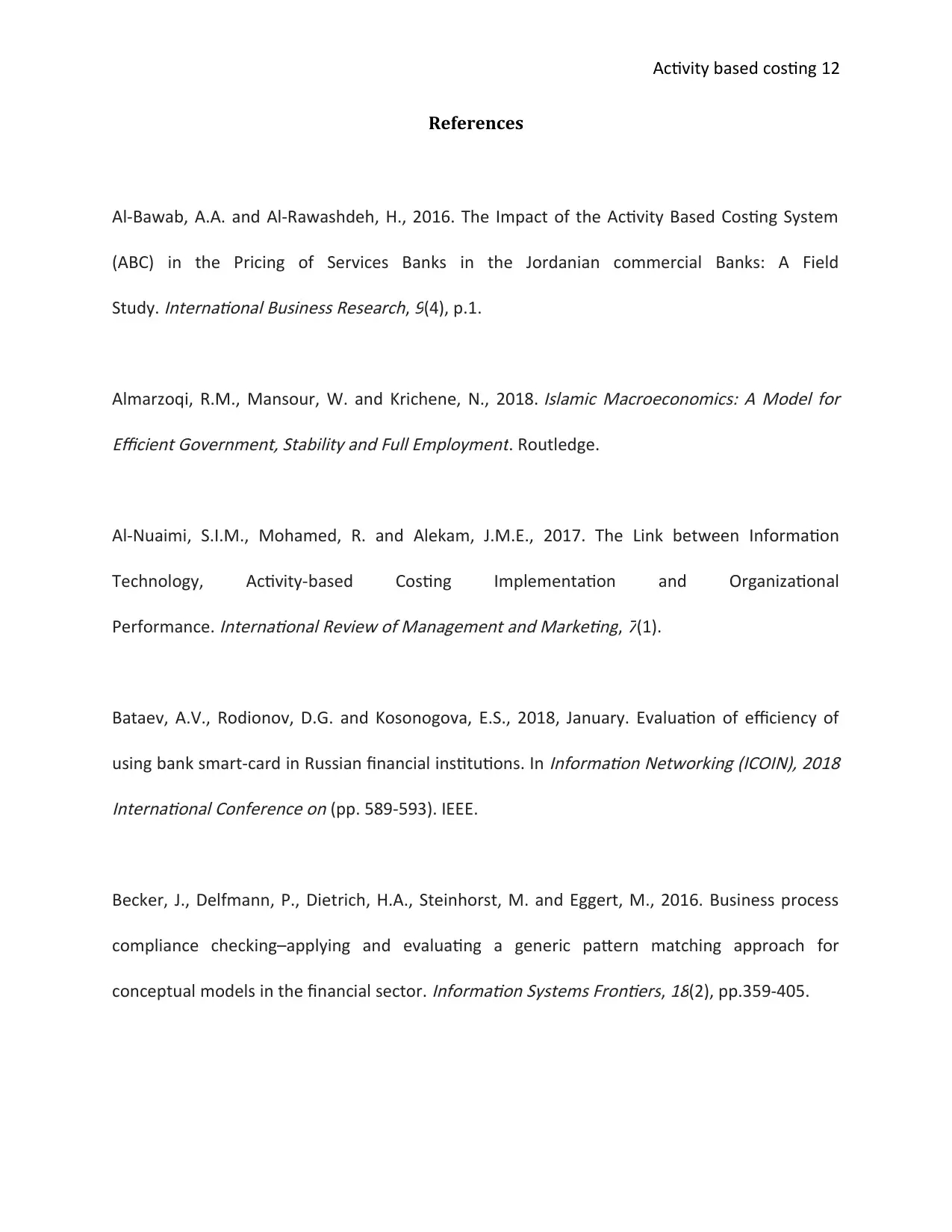
Activity based costing 12
References
Al-Bawab, A.A. and Al-Rawashdeh, H., 2016. The Impact of the Activity Based Costing System
(ABC) in the Pricing of Services Banks in the Jordanian commercial Banks: A Field
Study.
International Business Research,
9(4), p.1.
Almarzoqi, R.M., Mansour, W. and Krichene, N., 2018.
Islamic Macroeconomics: A Model for
Efficient Government, Stability and Full Employment. Routledge.
Al-Nuaimi, S.I.M., Mohamed, R. and Alekam, J.M.E., 2017. The Link between Information
Technology, Activity-based Costing Implementation and Organizational
Performance.
International Review of Management and Marketing,
7(1).
Bataev, A.V., Rodionov, D.G. and Kosonogova, E.S., 2018, January. Evaluation of efficiency of
using bank smart-card in Russian financial institutions. In
Information Networking (ICOIN), 2018
International Conference on (pp. 589-593). IEEE.
Becker, J., Delfmann, P., Dietrich, H.A., Steinhorst, M. and Eggert, M., 2016. Business process
compliance checking–applying and evaluating a generic pattern matching approach for
conceptual models in the financial sector.
Information Systems Frontiers,
18(2), pp.359-405.
References
Al-Bawab, A.A. and Al-Rawashdeh, H., 2016. The Impact of the Activity Based Costing System
(ABC) in the Pricing of Services Banks in the Jordanian commercial Banks: A Field
Study.
International Business Research,
9(4), p.1.
Almarzoqi, R.M., Mansour, W. and Krichene, N., 2018.
Islamic Macroeconomics: A Model for
Efficient Government, Stability and Full Employment. Routledge.
Al-Nuaimi, S.I.M., Mohamed, R. and Alekam, J.M.E., 2017. The Link between Information
Technology, Activity-based Costing Implementation and Organizational
Performance.
International Review of Management and Marketing,
7(1).
Bataev, A.V., Rodionov, D.G. and Kosonogova, E.S., 2018, January. Evaluation of efficiency of
using bank smart-card in Russian financial institutions. In
Information Networking (ICOIN), 2018
International Conference on (pp. 589-593). IEEE.
Becker, J., Delfmann, P., Dietrich, H.A., Steinhorst, M. and Eggert, M., 2016. Business process
compliance checking–applying and evaluating a generic pattern matching approach for
conceptual models in the financial sector.
Information Systems Frontiers,
18(2), pp.359-405.
⊘ This is a preview!⊘
Do you want full access?
Subscribe today to unlock all pages.

Trusted by 1+ million students worldwide
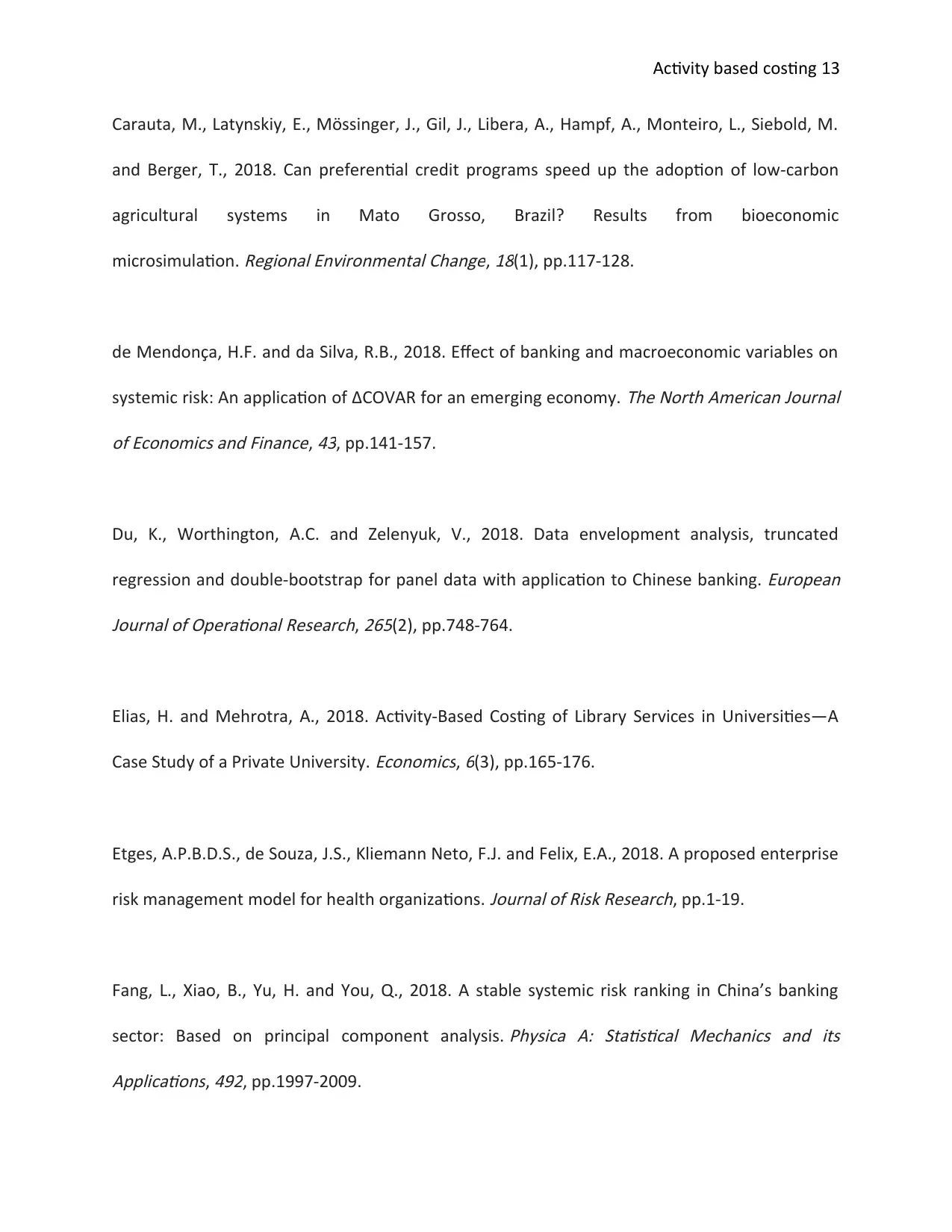
Activity based costing 13
Carauta, M., Latynskiy, E., Mössinger, J., Gil, J., Libera, A., Hampf, A., Monteiro, L., Siebold, M.
and Berger, T., 2018. Can preferential credit programs speed up the adoption of low-carbon
agricultural systems in Mato Grosso, Brazil? Results from bioeconomic
microsimulation.
Regional Environmental Change,
18(1), pp.117-128.
de Mendonça, H.F. and da Silva, R.B., 2018. Effect of banking and macroeconomic variables on
systemic risk: An application of ΔCOVAR for an emerging economy.
The North American Journal
of Economics and Finance,
43, pp.141-157.
Du, K., Worthington, A.C. and Zelenyuk, V., 2018. Data envelopment analysis, truncated
regression and double-bootstrap for panel data with application to Chinese banking.
European
Journal of Operational Research,
265(2), pp.748-764.
Elias, H. and Mehrotra, A., 2018. Activity-Based Costing of Library Services in Universities—A
Case Study of a Private University.
Economics,
6(3), pp.165-176.
Etges, A.P.B.D.S., de Souza, J.S., Kliemann Neto, F.J. and Felix, E.A., 2018. A proposed enterprise
risk management model for health organizations.
Journal of Risk Research, pp.1-19.
Fang, L., Xiao, B., Yu, H. and You, Q., 2018. A stable systemic risk ranking in China’s banking
sector: Based on principal component analysis.
Physica A: Statistical Mechanics and its
Applications,
492, pp.1997-2009.
Carauta, M., Latynskiy, E., Mössinger, J., Gil, J., Libera, A., Hampf, A., Monteiro, L., Siebold, M.
and Berger, T., 2018. Can preferential credit programs speed up the adoption of low-carbon
agricultural systems in Mato Grosso, Brazil? Results from bioeconomic
microsimulation.
Regional Environmental Change,
18(1), pp.117-128.
de Mendonça, H.F. and da Silva, R.B., 2018. Effect of banking and macroeconomic variables on
systemic risk: An application of ΔCOVAR for an emerging economy.
The North American Journal
of Economics and Finance,
43, pp.141-157.
Du, K., Worthington, A.C. and Zelenyuk, V., 2018. Data envelopment analysis, truncated
regression and double-bootstrap for panel data with application to Chinese banking.
European
Journal of Operational Research,
265(2), pp.748-764.
Elias, H. and Mehrotra, A., 2018. Activity-Based Costing of Library Services in Universities—A
Case Study of a Private University.
Economics,
6(3), pp.165-176.
Etges, A.P.B.D.S., de Souza, J.S., Kliemann Neto, F.J. and Felix, E.A., 2018. A proposed enterprise
risk management model for health organizations.
Journal of Risk Research, pp.1-19.
Fang, L., Xiao, B., Yu, H. and You, Q., 2018. A stable systemic risk ranking in China’s banking
sector: Based on principal component analysis.
Physica A: Statistical Mechanics and its
Applications,
492, pp.1997-2009.
Paraphrase This Document
Need a fresh take? Get an instant paraphrase of this document with our AI Paraphraser
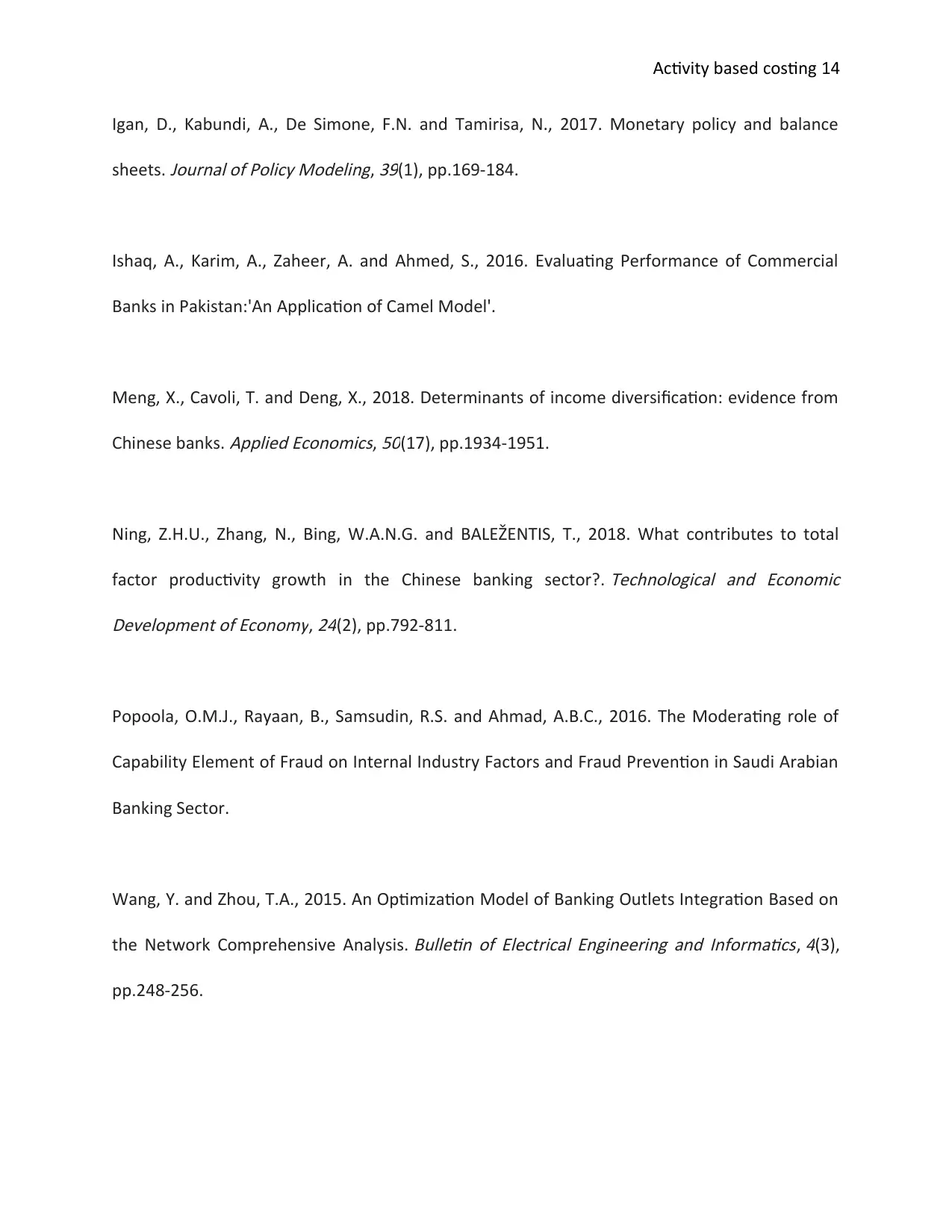
Activity based costing 14
Igan, D., Kabundi, A., De Simone, F.N. and Tamirisa, N., 2017. Monetary policy and balance
sheets.
Journal of Policy Modeling,
39(1), pp.169-184.
Ishaq, A., Karim, A., Zaheer, A. and Ahmed, S., 2016. Evaluating Performance of Commercial
Banks in Pakistan:'An Application of Camel Model'.
Meng, X., Cavoli, T. and Deng, X., 2018. Determinants of income diversification: evidence from
Chinese banks.
Applied Economics,
50(17), pp.1934-1951.
Ning, Z.H.U., Zhang, N., Bing, W.A.N.G. and BALEŽENTIS, T., 2018. What contributes to total
factor productivity growth in the Chinese banking sector?.
Technological and Economic
Development of Economy,
24(2), pp.792-811.
Popoola, O.M.J., Rayaan, B., Samsudin, R.S. and Ahmad, A.B.C., 2016. The Moderating role of
Capability Element of Fraud on Internal Industry Factors and Fraud Prevention in Saudi Arabian
Banking Sector.
Wang, Y. and Zhou, T.A., 2015. An Optimization Model of Banking Outlets Integration Based on
the Network Comprehensive Analysis.
Bulletin of Electrical Engineering and Informatics,
4(3),
pp.248-256.
Igan, D., Kabundi, A., De Simone, F.N. and Tamirisa, N., 2017. Monetary policy and balance
sheets.
Journal of Policy Modeling,
39(1), pp.169-184.
Ishaq, A., Karim, A., Zaheer, A. and Ahmed, S., 2016. Evaluating Performance of Commercial
Banks in Pakistan:'An Application of Camel Model'.
Meng, X., Cavoli, T. and Deng, X., 2018. Determinants of income diversification: evidence from
Chinese banks.
Applied Economics,
50(17), pp.1934-1951.
Ning, Z.H.U., Zhang, N., Bing, W.A.N.G. and BALEŽENTIS, T., 2018. What contributes to total
factor productivity growth in the Chinese banking sector?.
Technological and Economic
Development of Economy,
24(2), pp.792-811.
Popoola, O.M.J., Rayaan, B., Samsudin, R.S. and Ahmad, A.B.C., 2016. The Moderating role of
Capability Element of Fraud on Internal Industry Factors and Fraud Prevention in Saudi Arabian
Banking Sector.
Wang, Y. and Zhou, T.A., 2015. An Optimization Model of Banking Outlets Integration Based on
the Network Comprehensive Analysis.
Bulletin of Electrical Engineering and Informatics,
4(3),
pp.248-256.
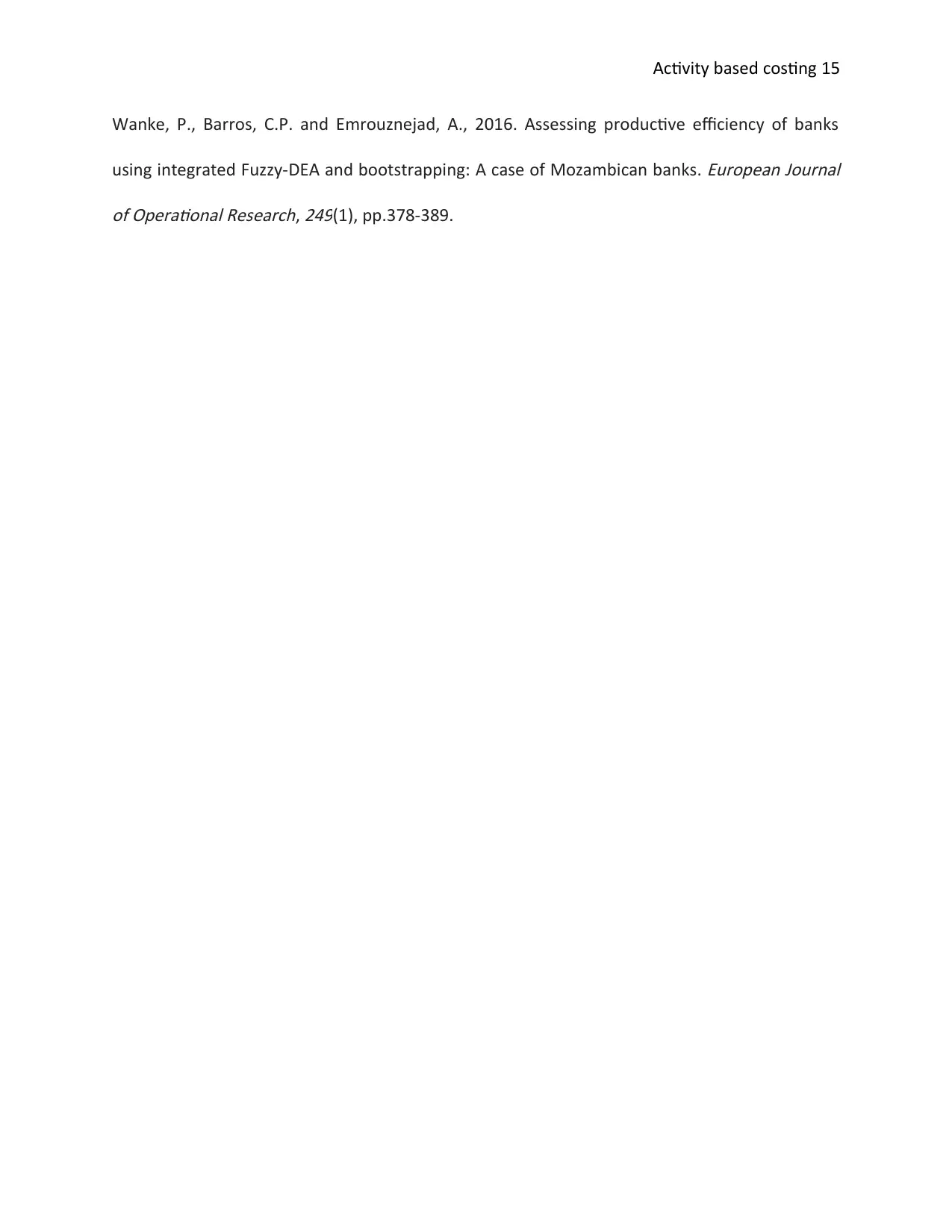
Activity based costing 15
Wanke, P., Barros, C.P. and Emrouznejad, A., 2016. Assessing productive efficiency of banks
using integrated Fuzzy-DEA and bootstrapping: A case of Mozambican banks.
European Journal
of Operational Research,
249(1), pp.378-389.
Wanke, P., Barros, C.P. and Emrouznejad, A., 2016. Assessing productive efficiency of banks
using integrated Fuzzy-DEA and bootstrapping: A case of Mozambican banks.
European Journal
of Operational Research,
249(1), pp.378-389.
⊘ This is a preview!⊘
Do you want full access?
Subscribe today to unlock all pages.

Trusted by 1+ million students worldwide
1 out of 15
Related Documents
Your All-in-One AI-Powered Toolkit for Academic Success.
+13062052269
info@desklib.com
Available 24*7 on WhatsApp / Email
![[object Object]](/_next/static/media/star-bottom.7253800d.svg)
Unlock your academic potential
© 2024 | Zucol Services PVT LTD | All rights reserved.





